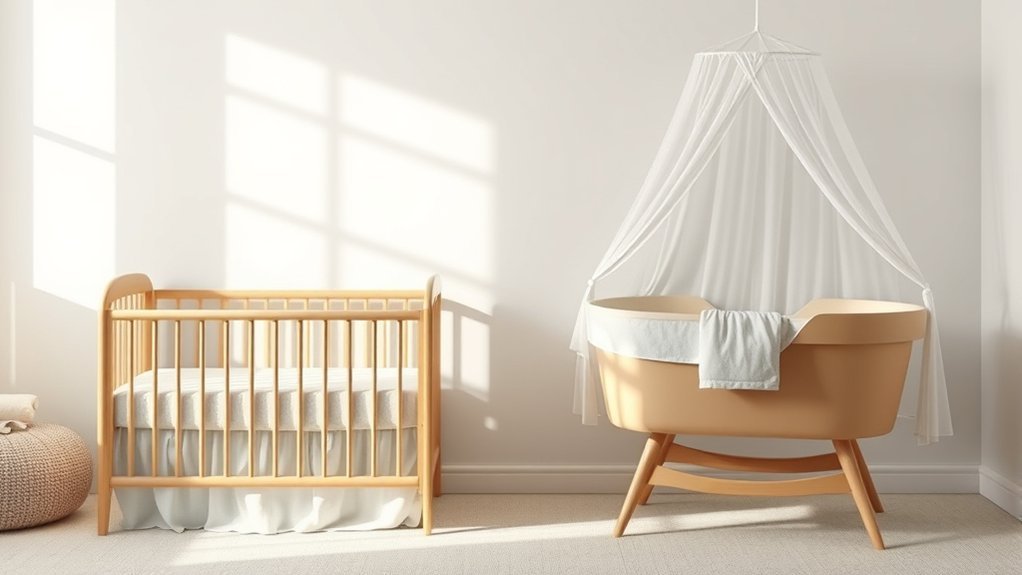When it comes to choosing between a crib and a bassinet, many parents fall prey to common myths that can influence their decision. You might think bassinets are always safer or more comfortable, but the reality is more nuanced. Understanding the key differences in safety standards, space, and long-term value is vital. As you weigh your options, consider what truly meets your family’s needs and what might surprise you about these two sleeping solutions.
Understanding Cribs and Bassinets: Key Differences
When choosing a sleep space for your newborn, understanding the key differences between cribs and bassinets is essential.
Cribs typically offer more robust features, such as adjustable mattress heights and convertible designs that grow with your child. They’re sturdy and spacious, suitable for long-term use.
On the other hand, bassinets provide unique benefits for newborns, like portability and a cozy, enclosed space that mimics the womb. Their lightweight design allows you to keep your baby close at night or easily move them from room to room.
Bassinets offer portability and a snug environment, keeping your newborn close and comfortable throughout the night.
Both options serve specific needs, so consider your lifestyle and space. By weighing crib features against bassinet benefits, you’ll make an informed choice that supports both your baby’s comfort and your family’s needs.
Safety Standards: What You Need to Know
Understanding the differences between cribs and bassinets is only the first step in guaranteeing your baby’s safety during sleep.
You must also familiarize yourself with the safety regulations that govern each option. Cribs generally adhere to stricter standards, often including features like slats that are spaced appropriately to prevent entrapment.
Bassinets, while portable and convenient, must also meet infant safety guidelines, including weight limits and stability requirements. Always check for certification labels to guarantee compliance with the latest safety standards.
Remember, your baby’s sleep environment should be free from hazards, such as loose bedding or soft toys.
Prioritizing these safety measures empowers you to create a secure and nurturing space for your little one.
Sleep Space: Size and Comfort Considerations
Choosing the right sleep space for your baby involves careful consideration of both size and comfort.
It’s essential to guarantee that your baby feels secure and cozy while you find the best sleeping arrangements. Here are some factors to keep in mind:
- Size: Ensure the sleep space fits comfortably in your room.
- Mattress Quality: A firm mattress can enhance comfort levels and safety.
- Breathability: Opt for materials that promote airflow to prevent overheating.
- Adjustability: Some bassinets offer adjustable heights for better accessibility.
- Mobility: Consider how easy it’s to move the sleep space for nighttime feedings.
Mobility and Convenience: Which Is Better for Parents?
How do mobility and convenience factor into your choice between a crib and a bassinet?
When it comes to travel ease, bassinets often shine. Their lightweight design allows you to move them from room to room or take them on trips, enhancing parent accessibility. You can easily place a bassinet beside your bed for nighttime feedings or in the living room while you tackle daily tasks.
In contrast, cribs, while sturdy and spacious, lack that same portability. If you value being close to your baby throughout the day, a bassinet might be the better option.
Ultimately, weighing these factors can empower you to make a choice that suits your lifestyle and fosters a nurturing environment for your little one.
Longevity and Value: Cost-Effectiveness Over Time
When evaluating the long-term investment of baby furniture, longevity and value play significant roles in your decision between a crib and a bassinet.
A value comparison reveals that cribs typically outlast bassinets, offering more cost-effectiveness over time.
Here are key points to evaluate:
- Usage Duration: Cribs can be used from infancy to toddlerhood, while bassinets typically last only a few months.
- Resale Value: Cribs often retain higher resale value due to their durability.
- Adaptability: Some cribs convert into toddler beds, extending their life.
- Quality: Higher-quality cribs can withstand wear, making them a worthwhile investment.
- Safety Standards: Cribs must meet strict safety regulations, ensuring your child’s well-being over the years.
Ultimately, choosing wisely supports both your budget and your child’s comfort.
Frequently Asked Questions
Can I Use a Crib or Bassinet for Co-Sleeping?
You shouldn’t co-sleep with your infant in a crib or bassinet due to co-sleeping safety concerns. Instead, place your baby in a separate sleep space to guarantee safe infant sleep and reduce risks.
What Are the Best Materials for a Crib or Bassinet?
When choosing a crib or bassinet, opt for solid wood or high-quality metals. These materials guarantee durability and compliance with safety standards, providing a secure haven for your little one, like a fortress of comfort.
How Often Should I Clean My Crib or Bassinet?
You should clean your crib or bassinet weekly for safe cleaning. Regularly check for spills and stains, and don’t hesitate to clean more often if needed. A clean space promotes a healthy environment for your baby.
Are There Specific Brands Recommended for Cribs or Bassinets?
When choosing a crib or bassinet, brands like Graco and Babyletto shine for safety ratings. Explore brand comparisons to find the perfect fit, ensuring your little one sleeps safely and soundly, like a dream.
Can I Use a Bassinet for Overnight Outings or Travel?
Yes, you can use a travel bassinet for overnight outings. These bassinets are lightweight and portable, making them ideal for trips. Verify it meets safety standards to guarantee your baby sleeps soundly wherever you go.
Conclusion
In traversing the crib versus bassinet debate, it’s vital to separate myths from facts. While bassinets might seem cozy, cribs offer superior safety and longevity. Consider your lifestyle and your baby’s needs as you make this significant decision. But wait—what if the choice you make today could impact your child’s sleep habits for years to come? Explore deeper into the facts and guarantee you’re making the best choice for your little one’s future.
